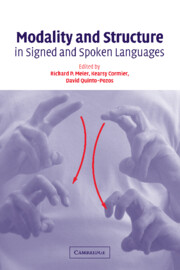Book contents
- Frontmatter
- Contents
- List of figures
- List of tables
- List of contributors
- Acknowledgements
- 1 Why different, why the same? Explaining effects and non-effects of modality upon linguistic structure in sign and speech
- Part I Phonological structure in signed languages
- 2 Modality differences in sign language phonology and morphophonemics
- 3 Beads on a string? Representations of repetition in spoken and signed languages
- 4 Psycholinguistic investigations of phonological structure in ASL
- 5 Modality-dependent aspects of sign language production: Evidence from slips of the hands and their repairs in German Sign Language
- 6 The role of Manually Coded English in language development of deaf children
- Part II Gesture and iconicity in sign and speech
- Part III Syntax in sign: Few or no effects of modality
- Part IV Using space and describing space: Pronouns, classifiers, and verb agreement
- Index
- References
5 - Modality-dependent aspects of sign language production: Evidence from slips of the hands and their repairs in German Sign Language
Published online by Cambridge University Press: 22 September 2009
- Frontmatter
- Contents
- List of figures
- List of tables
- List of contributors
- Acknowledgements
- 1 Why different, why the same? Explaining effects and non-effects of modality upon linguistic structure in sign and speech
- Part I Phonological structure in signed languages
- 2 Modality differences in sign language phonology and morphophonemics
- 3 Beads on a string? Representations of repetition in spoken and signed languages
- 4 Psycholinguistic investigations of phonological structure in ASL
- 5 Modality-dependent aspects of sign language production: Evidence from slips of the hands and their repairs in German Sign Language
- 6 The role of Manually Coded English in language development of deaf children
- Part II Gesture and iconicity in sign and speech
- Part III Syntax in sign: Few or no effects of modality
- Part IV Using space and describing space: Pronouns, classifiers, and verb agreement
- Index
- References
Summary
Introduction
In the present study, we investigate both slips of the hand and slips of the tongue in order to assess modality-dependent and -independent effects in language production. As a broader framework, we adopt the paradigm of generative grammar, as it has developed over the past 40 years (Chomsky 1965; 1995, and related work of other generativists). Generative Grammar focuses on both universal and language-particular aspects of language. The universal characteristics of language are known as Universal Grammar (henceforth, UG). UG defines the format of possible human languages and delimits the range of possible variation between languages. We assume that languages are represented and processed by one and the same language module (Fodor 1983), no matter what modality they use. UG is neutral with regard to the modality in which a particular language is processed (Crain and Lillo-Martin 1999).
By adopting a psycholinguistic perspective, we ask how a speaker's or signer's knowledge of language is put to use during the production of language. So far, models of language production have mainly been developed on the basis of spoken languages ((Fromkin 1973; Garrett 1975, 1980, Butterworth 1980 Levelt 1989, Levelt, Roelofs and Meyer 1999, Dell 1986, Dell and Reich 1981, MacKay 1987, Stemberger 1985). But, even the set of spoken languages investigated so far is restricted (with a clear focus on English). Thus, Levelt, Roelofs and Meyer (1999: 36) challenge researchers to consider a greater variety of (spoken) languages in order to broaden the empirical basis for valid theoretical inductions.
- Type
- Chapter
- Information
- Modality and Structure in Signed and Spoken Languages , pp. 112 - 142Publisher: Cambridge University PressPrint publication year: 2002
References
- 41
- Cited by



